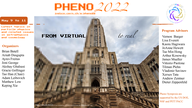Speaker
Description
As cosmological data have improved, tensions have arisen. One such tension is the difference between the locally measured Hubble constant $H_0$ and the value inferred from the cosmic microwave background (CMB). Interacting radiation has been suggested as a solution, but studies show that conventional models are precluded by high-ℓ CMB polarization data. It seems at least plausible that a solution may be provided by related models that distinguish between high- and low-ℓ multipoles. When interactions of strongly-coupled radiation are mediated by a force-carrier that becomes non-relativistic, the dark radiation undergoes a "step" in which its relative energy density increases as the mediator deposits its entropy into the lighter species. If this transition occurs while CMB-observable modes are inside the horizon, high- and low-ℓ peaks are impacted differently, corresponding to modes that enter the horizon before or after the step. These dynamics are naturally packaged into the simplest supersymmetric theory, the Wess-Zumino model, with the mass of the scalar mediator near the eV-scale. We investigate the cosmological signatures of such "Wess-Zumino Dark Radiation" (WZDR) and find that it provides an improved fit to the CMB alone, favoring larger values of $H_0$. Utilizing a standardized set of measures, we compare to other models and find that WZDR is among the most successful at addressing the $H_0$ tension.

